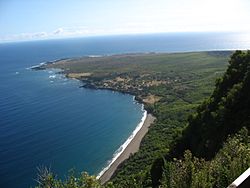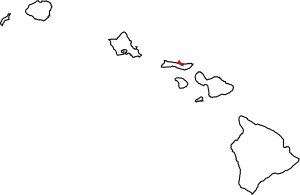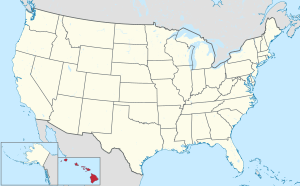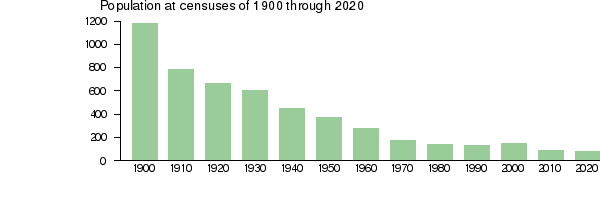Kalawao County, Hawaii facts for kids
Quick facts for kids
Kalawao County
|
|
|---|---|

Kalaupapa peninsula
|
|

Location within the U.S. state of Hawaii
|
|
 Hawaii's location within the U.S. |
|
| Country | |
| State | |
| Founded | 1905 |
| Named for | Kalawao |
| Seat | none (administered by Hawaii Dept. of Health) |
| Largest community | Kalaupapa |
| Area | |
| • Total | 53 sq mi (140 km2) |
| • Land | 12 sq mi (30 km2) |
| • Water | 41 sq mi (110 km2) 77.3% |
| Population
(2020)
|
|
| • Total | 82 |
| • Density | 1.547/sq mi (0.597/km2) |
| Time zone | UTC−10 (Hawaii–Aleutian) |
| • Summer (DST) | HADT |
| Congressional district | 2nd |
Kalawao County (Hawaiian: Kalana o Kalawao) is a county in the U.S. state of Hawaii. It is the smallest county in the 50 states by land area and the second-smallest county by population, after Loving County, Texas. The county encompasses the Kalaupapa or Makanalua Peninsula, on the north coast of the island of Molokaʻi. The small peninsula is isolated from the rest of Molokaʻi by cliffs over a quarter-mile high; the only land access is a mule trail.
Due to the small population (82 as of the 2020 United States Census), Kalawao County does not have the same functions as other Hawaii counties. Instead, it operates as a judicial district of Maui County, which includes the rest of the island of Molokaʻi. The county has no elected government.
It was developed and used from 1866 to 1969 for settlements for treatment of quarantined persons with Hansen's disease (leprosy).
Contents
History
The Kingdom of Hawaiʻi, the Republic of Hawaiʻi, the Territory of Hawaii, and the state of Hawaii all exiled persons suffering from Hansen's disease (leprosy) to the peninsula, from 1866 to 1969. The quarantine policy was only lifted after effective antibiotic treatments were developed that could be administered on an outpatient basis and patients could be rendered non-contagious.
Many residents chose to remain in their familiar community on the peninsula. The state promised that they could live there for the rest of their lives. As of 2015, the population consisted of the remaining patients, plus state employees and park staff. Tourists 16 years of age and older and personal guests of residents may visit with prior government permission, and the general public must be part of an official tour.
In 1980, the Kalaupapa National Historical Park was established to preserve the county's history and environment.
Geography
According to the U.S. Census Bureau, the county has a total area of 53 square miles (140 km2), comprising 12 square miles (31 km2) of land and 41 square miles (110 km2) (77.3%) of water. By land area, it is the smallest true county in the United States; some independent cities in Virginia are smaller and are sometimes considered to be "county equivalents" for statistical purposes such as with the US Census Bureau.
Kalaupapa Peninsula
Kalaupapa Peninsula contains the county's only settlement, Kalaupapa. The Kalaupapa Peninsula developed from lava that erupted from the ocean floor near Kauhakō Crater and spread outward, forming a low shield volcano. This was the most recent volcanic episode on the island and of the larger East Molokaʻi shield volcano, occurring after the formation of the cliffs by erosion.
Subdivisions
Kalawao County is composed of four ahupuaʻa. From west to east:
| Ahupuaʻa | Area mi2 |
Area km2 |
Population | Description |
|---|---|---|---|---|
| Kalaupapa | 2.079 | 5.385 | 65 | West side of Kalaupapa peninsula. Includes a section of Molokaʻi's coast further west |
| Makanalua | 3.229 | 8.363 | 8 | Strip of land in the center of the peninsula that runs to its northern tip. Includes Kalaupapa Airport. |
| Kalawao | 3.294 | 8.531 | 9 | Eastern coast of Kalaupapa peninsula and Waialeia Valley to the southeast |
| Waikolu | 5.544 | 14.359 | 0 | Includes namesake valley. Uninhabited. |
| Kalawao County | 14.146 | 36.638 | 82 |
Demographics
| Historical population | |||
|---|---|---|---|
| Census | Pop. | %± | |
| 1900 | 1,177 | — | |
| 1910 | 785 | −33.3% | |
| 1920 | 667 | −15.0% | |
| 1930 | 605 | −9.3% | |
| 1940 | 446 | −26.3% | |
| 1950 | 340 | −23.8% | |
| 1960 | 279 | −17.9% | |
| 1970 | 172 | −38.4% | |
| 1980 | 144 | −16.3% | |
| 1990 | 130 | −9.7% | |
| 2000 | 147 | 13.1% | |
| 2010 | 90 | −38.8% | |
| 2020 | 82 | −8.9% | |
| 2023 (est.) | 81 | −10.0% | |
| U.S. Decennial Census 1790-1960 1900–1990 1990–2000 2010–2018 |
|||
As of the census of 2000, 147 people, 115 households, and 21 families resided in the county, declining to 90 inhabitants in 2010. The population density was 11 people per square mile (4.2 people/km2). The 172 housing units produced an average density of 13 per square mile (5.0/km2). The racial makeup of the county was 48% Pacific Islander, 26% White, 17% Asian, 3% from other races, and 6% from two or more races. Hispanic or Latino of any race made up 4%. Kalawao County has the highest Pacific Islander population percentage of any U.S. county, and is the only county where they make up a plurality.
2% of households housed children under the age of 18. 17% were married couples living together. 3% had a female householder with no husband present. 81% were non-families. 79% of all households were made up of individuals, and 31% had someone living alone who was 65 years of age or older. The average household size was 1.28 and the average family size was 2.27.
2% of residents were under the age of 18, 1% from 18 to 24, 18% from 25 to 44, 46% from 45 to 64, and 32% who were 65 years of age or older. The median age was 59 years. For every 100 females, there were 98.6 males. The population has declined since 1900:

Current residents include 16 former patients, 40 federal employees who work on preservation projects, and some state-employed health workers.
Transportation
The only access to Kalawao County is by air, or by a steep mule trail that descends 1,600 ft (490 m) from the rest of Molokaʻi. Kalaupapa Airport has scheduled air service to Molokaʻi Airport and to Honolulu Airport.
Freight is delivered to the county once a year, usually in July, by barge.
Education
The county is within the Hawaii Department of Education school district.
See also
 In Spanish: Condado de Kalawao para niños
In Spanish: Condado de Kalawao para niños

